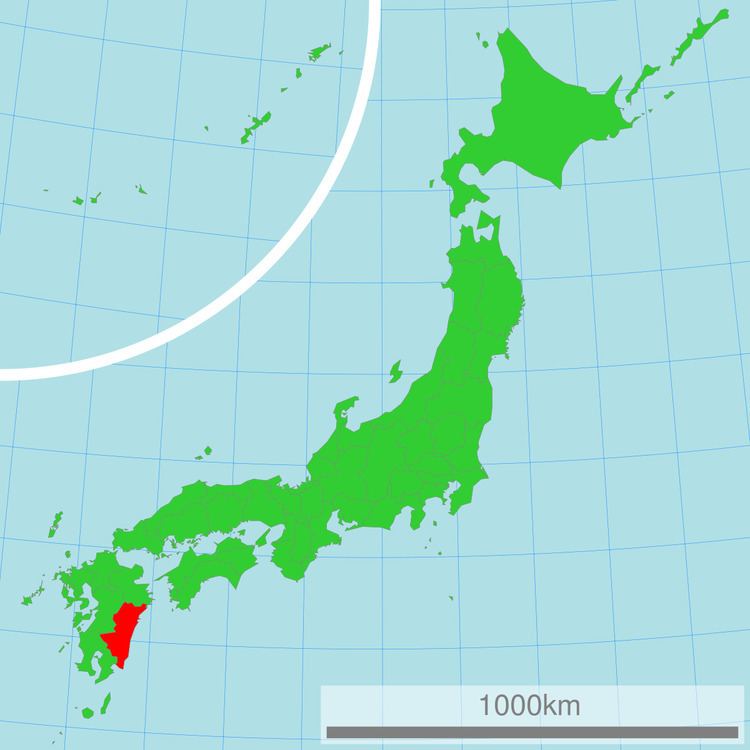Country Japan Area rank 19th | Region Kyushu ISO 3166 code JP-45 | |
 | ||
This is an outline of the history of Miyazaki Prefecture.
Contents
- Etymology
- Prehistoric Miyazaki
- Saitobaru Burial Mounds
- Yamato Ouken and Miyazaki
- Hyuga
- Shimazu Tadahisa the founder of the Shimazu Samurai clan
- Muromachi Period and Nanbokucho Period
- Edo Period
- Nobeoka Han
- Takanabe Han
- Sadowara Han
- The It clan and Obi Han
- The Shimazu clan and Miyazaki
- Meiji Era
- Peculiarities of the capital of Miyazaki Prefecture
- Miyazaki Shrine and Hakko Ichiu Monument
- Atarashiki mura movement
- Sightseeing and Miyazaki
- Hideo Higashikokubaru Governor of Miyazaki Prefecture 20072011
- References
Etymology
It was in Wamyo Ruijusho that Miyazaki first appeared in Japanese documents as one of the names of 5 guns (subprefecture) in Miyazaki. According to the History of Miyazaki Prefecture by Tsugiyoshi Hidaka Miyazaki might be the place where Emperor Jinmu, the mythological first emperor, lived, or the place of Miya, or his place.
Prehistoric Miyazaki
Saitobaru Burial Mounds
Yamato Ouken and Miyazaki
There are various Japanese names for a political/governmental organization present starting in the third century of kofun period in Kinki area of Japan, composed of several powerful families, with Oh (king) or Ohkimi (great king) as its center. These names include Yamato Choutei (Court), Yamato Ouken, Wa Ouken, and Yamato Seiken. At the same time, there are views that the presence of smaller regional states should be respected. There is a view that Choutei (Court) should not be used before the 4th and 5th century. At the present time, Yamato Ouken is tentatively used here. In the mythologies of country production, Miyazaki appeared as a part of Kumaso in Kyushu, but not as a unified force but it is considered to be a part of Kumaso-controlled area. By and by, the force of Yamato Ouken infiltrated from the Oita area southward. According to Nihon Shoki, a Japanese document, the offsprings of Prince Toyokuniwake, who followed Emperor Keiko, became the top of Hyuga, or agata-nushi, at Morokara.
Hyuga
After the establishment of the Ritsuryo system, the country of Hyuga had been called Himuka, facing the east. The control of Yamato Ouken was not strong, and in 702, Satsuma country, and in 713, Osumi country was separated, thus the country of Hyuga was determined. These countries were under the strong control of Yamato Ouken, or Dazaifu. In 815, there were 500 soldiers of the Yamato Ouken, and comparison of soldiers revealed more lower class soldiers than in other countries.
Shimazu Tadahisa, the founder of the Shimazu Samurai clan
In 1185, Shimazu Tadahisa (died August 1, 1227) was the founder of the Shimazu samurai clan. The Shimazu clan had become the daimyo of Satsuma and Osumi domains of Kagoshima and Hyuga country. He went to Satsuma in 1196, subdued Hyuga and Osumi provinces, and built a castle in the domain of Shimazu (Hyuga) which name he also adopted. He is buried in Kamakura, near his father's tomb.
Muromachi Period and Nanbokucho Period
Strongmen in Hyuga were Tsuchimochi, Ito, Kitahara and Shimazu, Hongo and Niiro. These strongmen fought against their enemies. Finally, Shimazu was most powerful, until the time of their defeat by Toyotomi Hideyoshi in 1587. Then Hyuga was given to various daimyos who fought for Hideyoshi.
Edo Period
In the Edo period, Hyuga was divided into many hans; the greatest was the Satsuma han of Kagoshima which belonged to Shimazu clan. Other hans included Nobeoka han, Takanabe han, Sadowara han and Obi han.
Nobeoka Han
Takanabe Han
Sadowara Han
The Itō clan and Obi Han
The Itō-family were a Japanese clan that claimed descent from the medieval warrior Itō Suketoki. The family became a moderate power both in influence and ability by the latter Sengoku Period of Feudal Japan. The Itō family survived through the Muromachi Period, and remained a powerful clan well into the Sengoku period. The Itō family's most serious rivals in this period were the Shimazu. The Shimazu clan, which had unified Satsuma Province and Ōsumi Province under their control, began to clash with the Itō in 1570. The Itō were finally defeated by the Shimazu in 1578. The family followed Toyotomi Hideyoshi's invasion of Kyushu and Itoh Suketake won the land of Obi, now Nichinan which became the Obi Domain. 23,000 koku which became 40,500 koku and a peak of 57,816 koku.
The Shimazu clan and Miyazaki
The Shimazu clan, the tozama daimyo, was a powerful clan and its territory spanned the provinces of Satsuma, Osumi and the south-west region of Hyūga, and had the Ryūkyū Kingdom as a vassal state. The territory is largely contiguous with today's Kagoshima prefecture, and parts of Miyazaki prefecture.
Meiji Era
Miyazaki Prefecture was placed, but it was made a part of Kagoshima Prefecture once. In 1883, Hyuga was separated from Kagoshima Prefecture, naming it Miyazaki Prefecture. A part of previously Hyuga remained in the Kagoshima Prefecture.
Peculiarities of the capital of Miyazaki Prefecture
Miyazaki Shrine and Hakko Ichiu Monument
Atarashiki-mura movement
Sightseeing and Miyazaki
Based on the History of Miyazaki Sightseeing,
